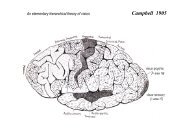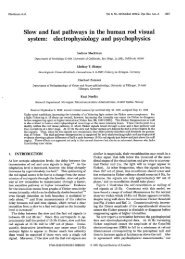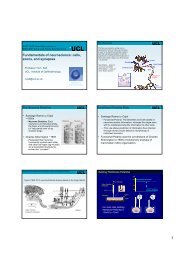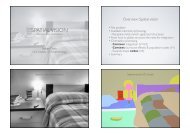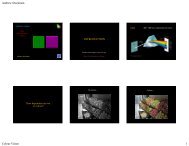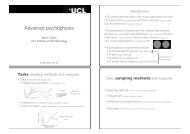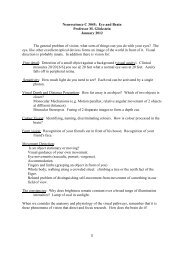Introduction to psychophysics
Introduction to psychophysics
Introduction to psychophysics
Create successful ePaper yourself
Turn your PDF publications into a flip-book with our unique Google optimized e-Paper software.
Signal detection theory (SDT; Green & Swets, 1966)• Trainee doc<strong>to</strong>rs ask “is a tumour present?” (“yes/no”, 50% present)• How do we assess performance?• Decisions limited by: information & criterionStimulusStimulusPresentAbsentResponse“Yes” “No” TotalHit, H (0.84) Miss (0.16) 1.0False alarm,FA (0.50)Correctreject (0.50)• ↑information high H, low FA (↑sensitivity)PresentAbsentResponse“Yes” “No” TotalHit, H (0.5) Miss (0.5) 1.0False alarm,FA (0.16)Correctreject (0.84)1.01.0• Doc<strong>to</strong>rs weigh errors differently• e.g. One considers missed diagnoses fatal,another minimises unnecessary procedures• Not information but bias/criterion that sets performanceNoise• Uncertainty on such tasks arises from two types of noiseIncreasing external noise →• External noise: measurements, variation in lung tissue• Assume doc<strong>to</strong>r uses neural responses <strong>to</strong> detect tumour,those responses are variable. This internal noise contributes<strong>to</strong> an internal responseCould be firing rate →noiseInternal-response probability ofoccurrence curves for noisealone & signal+noise trialsCriterion• Base response on some minimum/criterion responsed’=1.0• Effects of criterion shiftd’=1.0d’=1.0H=98%, FA=84% H=84%, FA=50% H=50%, FA=16%• Doc<strong>to</strong>rs cannot set their criterion <strong>to</strong> achieve only hits andno false alarms; noise overlap in prob. of occurrence curves internal responseon noise-alone must sometimes exceed signal+noise responseHit rate (H)1.0Betterdiscrim.Internal-response probability ofoccurrence curves for noisealone & signal+noise trialsReceiver operating curves & d’• Receiver operating curves (ROCs) plot a series of H/FAmeasurements; show choices made by doc<strong>to</strong>rd’=2d’=1d’=0.5d’=0random“Yes” Low0.5med.“No”highcriteriad’=z(H)-z(F)0.00.0 0.5 1.0False alarm rate rate (FA) (F)BiasNote upward bowingcurves (typically H>FA)• ↑ information (e.g. ↑signal) better separation• Reducing noise improves performance <strong>to</strong>o• Good measure of information content of internalrepresentation is: d’=separation/spread• ROC curves: practical & theoretical used’=1.0,lots of overlapd’=2.0less overlap



